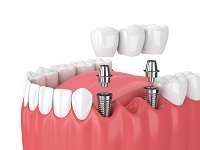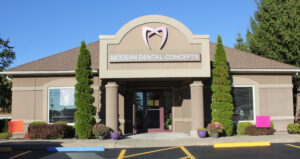
When you’re missing one or more teeth, a dental bridge between your existing teeth is often the best solution to fill in the space where the tooth once was. Bridges are long-lasting and can be made of multiple materials, such as tooth-colored alloys, porcelain, or other materials, such as gold or metal. The procedure is done in-office, involves two appointments, and anesthesia will be provided to minimize any discomfort or pain.
Why is it called a dental bridge?
A dental bridge literally ‘bridges’ the gap between missing teeth. The bridge itself is basically a false, or replacement tooth which is referred to in dentistry as a ‘pontic’. (The word pontis is Latin for bridge.) The pontic is similar to a crown, except the pontic does not have a root. Your healthy teeth on either side of the space are called abutments and they will need crowns to stabilize them and make them strong enough to support the pontic, or bridge.
Depending on your situation, variables that affect your bridgework include:
- How many teeth are missing
- The location of missing teeth
- The amount of support given from each abutment tooth
- The amount of bone left below the surface in the root
- The size and length of the root for each tooth
Once Dr. Nadler or Dr. Sheth-Nadler has a plan for your bridgework, the doctor will prepare the surrounding support teeth so there is adequate room for your support system. Preparation involves recontouring these teeth by removing a portion of enamel to allow room for a crown to be placed over them. Next, the doctor will take scans of the teeth and the area where the bridge will go and send the information off to the lab where your permanent bridge will be fabricated. The lab will then create the bridge (consisting of the pontic piece and the adjoining crowns) to fit snugly over the abutment teeth. While the lab work is being done, a temporary bridge will be provided to help keep the abutments supported while your permanent bridge is being built.
At your second visit, the doctor will affix your permanent bridge, making sure the fit is flawless and it’s permanently in place. With proper dental care, a dental bridge can be a permanent solution for missing teeth and can last up to 10 years or more.
Dental Bridge Benefits
- Improve your smile
- Restore the ability to chew and speak
- Maintain the shape of your face
- Improve ‘bite’ and tooth alignment
- Prevent remaining teeth from shifting out of position
Types of Dental Bridges
- Traditional bridge – two abutments (crowns) anchor a false tooth. This is the most popular type of bridge.
- Cantilever bridge – requires only one crown for support. A good option for healthy teeth, but carries an increased risk of tooth or jaw damage
- Maryland bridge – the bridge is anchored by a metal or porcelain framework attached to the backs of teeth on either side of the gap.
- Implant-supported bridge – uses dental implants as anchors. More expensive and invasive, but more secure.
Which type of bridge is right for you? We’ll walk you through the bridgework process – it’s easy when you know-how. Call (330) 847-0676 today!




